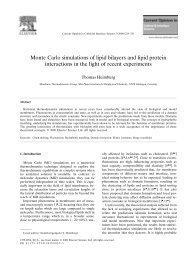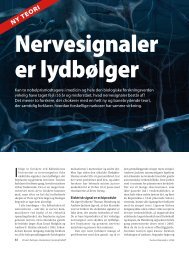Electric Gradient Field Applied to Lipid Monolayers - Membrane
Electric Gradient Field Applied to Lipid Monolayers - Membrane
Electric Gradient Field Applied to Lipid Monolayers - Membrane
You also want an ePaper? Increase the reach of your titles
YUMPU automatically turns print PDFs into web optimized ePapers that Google loves.
CHAPTER 5. MATERIALS AND METHODS 37<br />
It was assumed that an applied electric gradient field would have changed the shapes<br />
and edges of the lipid domains. Imaging of such changes required high optical resolution<br />
produced from an immersion media objective of high magnification. Such objectives have<br />
high Numerical Apertures (NA > 1) and very short working distances (WD) typically of<br />
100µm - 200µm. NA is a unit less number that defines the size of the focus point i.e. the<br />
optical resolution. More strictly<br />
NA = n · sin(θ cone ) (5.3)<br />
where n is the refractive index of the immersion media 1.00 for air 1.2 for pure water<br />
and θ cone is the half of the maximum angle of the light cone entering the objective.<br />
The working distance is defined as the shortest distance<br />
from the focus point <strong>to</strong> the objective which is the outer<br />
glass covering the lenses see fig. 5.5. Thus, (WD) is includes<br />
the thickness of the coverglass 170µm and the level<br />
of the water above this glass. Further more the distance<br />
from the water <strong>to</strong> the electrode was at least 200µm. For<br />
practical reasons high (WD) was used which enabled using<br />
of the focus point <strong>to</strong> locate the <strong>to</strong>p electrode above<br />
the water. The field only caused small changes of the<br />
water level < 2µm estimated without lipids. This effect<br />
was neglected.<br />
Constrained by the required (WD) and a high optical<br />
resolution the choice felt on LCPlanFl 40x see fig. 5.5<br />
which fitted the conditions very good. Data of objective: Fig. 5.5: Infinity corrected objective<br />
used in monolayer experiments and<br />
Olympus LCPlanFl 40x, NA = 0.60, WD = 2.15mm, Flat<br />
field correction i.e. the normally projected curved image introducing definitions. No immersion<br />
media, 40x magnification, WD =<br />
is corrected <strong>to</strong> a flat image. Fluorite correction for green<br />
2.15mm, NA = 0.6, f = 4.5mm<br />
and blue light. Correction <strong>to</strong> infinity image distance and<br />
for a 0.17mm thick cover glass.<br />
Excitation of the fluororphore happens at a wavelength of 532nm green light using a<br />
200mW <strong>to</strong>rus laser (Laser Quantum, GB) with a beam wide of ω = 0.85mm. To ensure full<br />
limitation of the back focal plane of the objective the narrow gausian beam from the laser<br />
was expanded by two lenses (L1) and (L2) with the focal lengths of respectively 12.5mm<br />
and 200mm. The expanded laser beam then had a width of<br />
ω expand = 0.85mm 200mm<br />
12.5mm<br />
= 14mm (5.4)<br />
This is much higher than the diameter of aperture of the chosen objective 5.5mm. Not<br />
<strong>to</strong> loose beam intensity by over illumination of the back focal plane of the objective the<br />
beam was truncated by a lens before entering the objective (L3). This has focal length<br />
of 300mm and was positioned <strong>to</strong> ensure full illumination of the back focal plane of the<br />
objective. The laser beam was directed through a dichroic mirror and reflected vertical up







